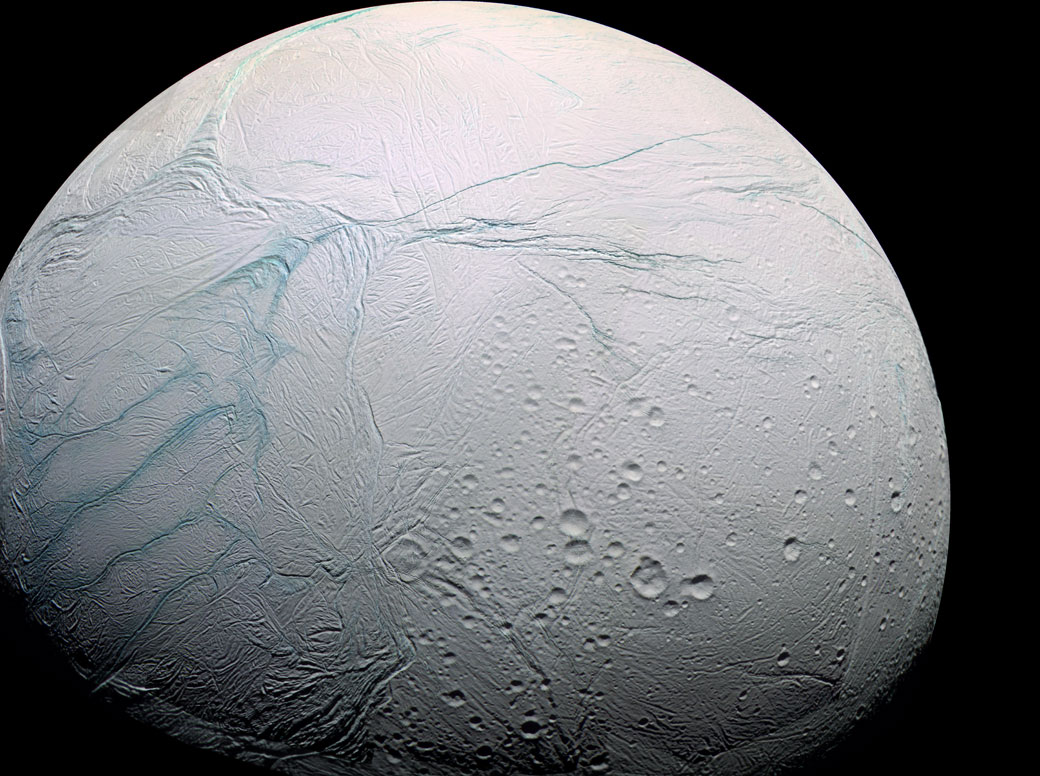TORONTO – Researchers have confirmed that a large ocean of water exists beneath Enceladus, a tiny moon orbiting Saturn.

The discovery is particularly exciting since many scientists believe that Enceladus is one of two of the best places for life in our solar system. Jupiter’s moon Europa is the other.
READ MORE: The 4 best places for life in our solar system
Both moons have icy crusts, and it was long suspected that water lay beneath their surfaces. But how much water wasn’t known.
“We knew there was liquid water, but we didn’t know the extent, the mass, the geometry of the liquid water,” Luciano Iess at Sapienza Università di Roma in Rome, Italy, told Global News. “Could there have been rather shallow, relatively tiny water pockets just beneath the surface? We didn’t know.”
Enceladus is particularly interesting. Not only does it have an icy surface, but it also has geysers of water and ice particles that shoot into space.
In order to determine how much water lay beneath the surface of Enceladus, researchers, led by Iess, used NASA’s Cassini spacecraft — in orbit around Saturn since 2004 — to investigate the moon’s gravity field. What they found was that the southern polar region of Enceladus doesn’t have enough mass at its surface to account for the southern hemisphere’s gravity field.
Iess and his team used Doppler data from three of Cassini’s flybys that brought the spacecraft about 100 km from the moon’s surface.
With this data, the researchers were able to determine that Enceladus’s ocean is sandwiched between the rocky core and the icy crust. The ice is about 40 to 50 km thick; beneath that, the ocean extends about 10 km, and then reaches the rocky core that likely contains silicates extending about 200 km.
Though Cassini flew over the moon’s north pole, there’s no telling whether or not this sub-surface ocean is global or not, though the composition of the moon suggests that it may not be. Both hemispheres are very different, with the northern hemisphere appearing much older than the southern.
- Invasive strep: ‘Don’t wait’ to seek care, N.S. woman warns on long road to recovery
- Ontario First Nation declares state of emergency amid skyrocketing benzene levels
- Do Canadians have an appetite for electric vehicles? Experts are divided
- Nearly 200 fossil fuel, chemical lobbyists to join plastic treaty talks in Ottawa
Does this mean the chilly world has life lying beneath it?
“The value of the discovery would be enormous,” Iess said of the possibility of finding life in its early stages. However, the only thing the recent findings can confirm, he stressed, is the discovery of water that interacts with silicates beneath the surface. That does hold some promise of some prebiotic life.
“This is certainly interesting. There might exist prebiotic conditions there,” said Iess. “But from here, to say that there is life in the ocean of Enceladus, nobody can tell.”
Even if life exists, there would be no way of determining that from orbit. A mission that could delve beneath the moon’s 40 km of ice would be needed, but it would be essential that no contaminants from Earth make the voyage.
Still, Iess said that the discovery of water interacting with silicates — which makes it a good candidate for fostering life — is a wonderful discovery.
“The real surprise is that we’ve been able to find potentially habitable environments… in places of the solar system that were completely unexpected,” said Iess.
On Earth, life has been found in some inhospitable places, such as in the ocean with very little or no light, or areas with no oxygen.
“Life, when it emerges, finds its way almost everywhere,” Iess said.
The findings will be published in the April 4 issue of Science.




Comments